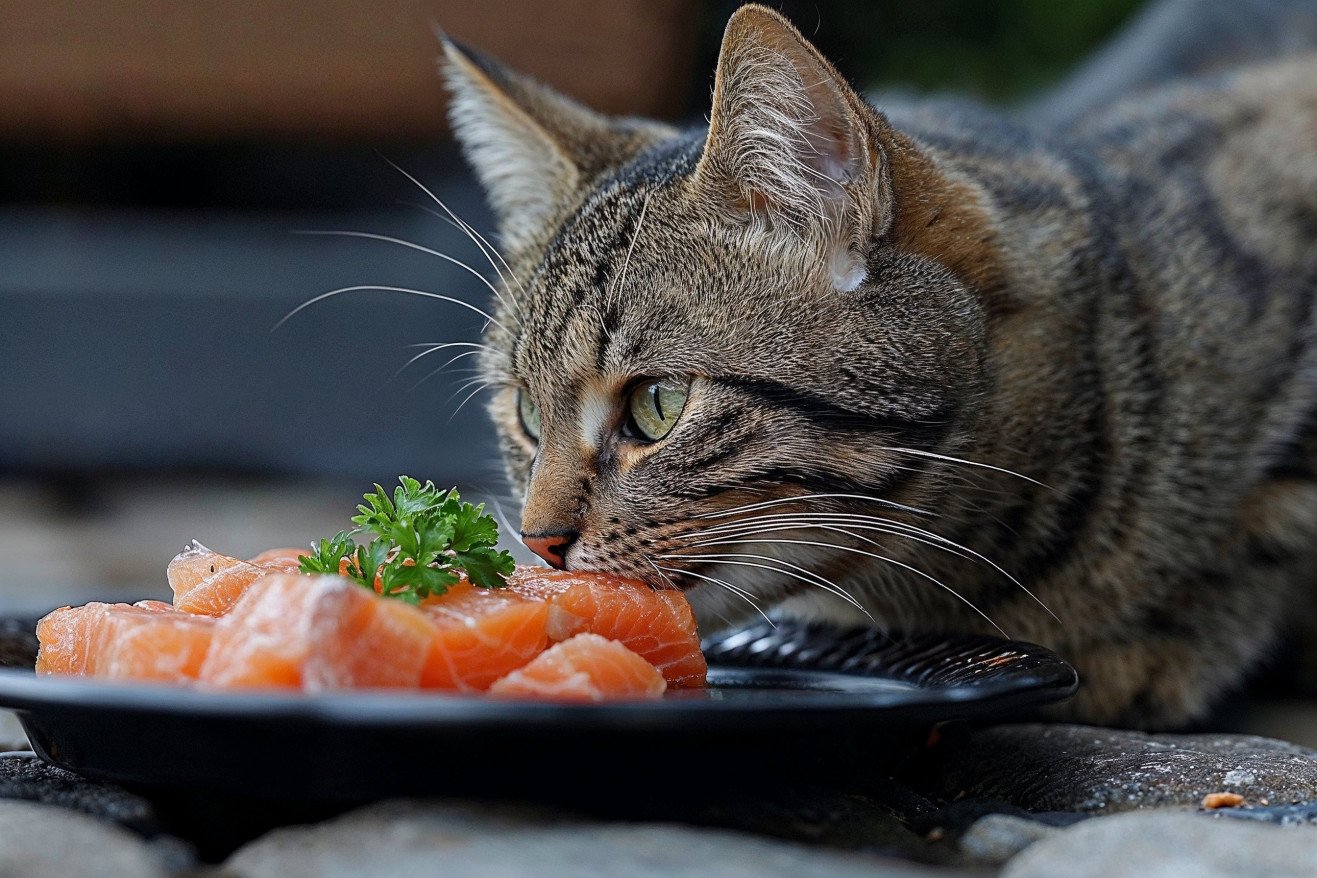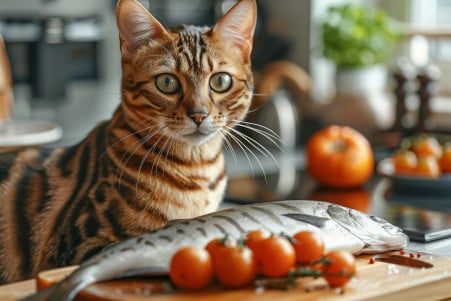Can Cats Eat Salmon? A Nutritional Guide for Feline Diets
20 January 2024 • Updated 28 January 2024

Salmon is a nutrient-dense and tasty fish, so it may seem like a good choice for your cat’s next meal, but is it safe? The answer is yes, cats can eat salmon, but it should be consumed in moderation and as part of a balanced diet.
Opt for cooked salmon since raw salmon can carry bacteria and parasites that can make your cat sick. Also, make sure to remove the head, tail, and bones to avoid choking hazards.
We’ll cover the in-depth nutritional breakdown of salmon and how it meets a cat’s nutritional requirements, the best ways to serve it, and how often you can feed it to your cat while keeping them safe. Throughout this article, we’ll reference veterinary research, nutritional recommendations, and the latest findings in cat nutrition. This information will help you know how to feed your cat salmon in a way that supports their health.
Can cats eat salmon?
The Nutritious Catch: How Salmon Helps Cats
Salmon is a great source of protein and Omega-3 fatty acids, both of which are important parts of a cat’s diet. According to the USDA FoodData Central, salmon is high in protein and other nutrients that help cats build and maintain strong muscles and stay healthy.
Omega-3 fatty acids, especially EPA and DHA, help with joint health, heart health, and are important for good eyesight. They also help keep a cat’s coat shiny and their skin healthy and support cognitive function with a variety of B vitamins, including niacin, B6, and B12.
Salmon’s vitamin D helps cats maintain healthy bones and supports growth, and selenium is important for antioxidant support. Including salmon in a cat’s diet can be very beneficial, according to WagWalking, but it’s important to make sure it’s done in moderation.
In fact, many experts recommend that treats or human food, like salmon, should make up no more than 10–15% of a cat’s daily intake to avoid nutritional imbalances. By doing this, you can make sure your cat gets the benefits of salmon without any negative effects.
A Word of Warning: The Dangers of Feeding Cats Salmon
Although salmon can be a healthy part of a cat’s diet, there are some dangers to be aware of. Cats should not eat raw salmon due to the parasites, including those that cause anisakiasis, and bacteria it can contain. The Centers for Disease Control and Prevention (CDC) even warns that cats can get a parasitic infection from eating raw or undercooked fish.
In addition, salmon bones can pose a choking or internal injury hazard. The bones can splinter and cause damage to the mouth, throat, or gastrointestinal tract. Properly preparing salmon, which includes ensuring it is boneless and cooked all the way through, is important to keep your cat safe.
There is also a concern about mercury in fish. While low levels are generally safe, eating too much fish that contains high levels of mercury can lead to mercury poisoning.
Finally, don’t forget about food allergies. According to PetMD, fish is a common allergen for cats. Signs of an allergic reaction can include itching, skin lesions, and gastrointestinal problems. Make sure to watch your cat for any signs of distress after eating salmon to make sure they are okay.
How to Feed Salmon to Your Cat: Portion and Frequency Tips
While salmon can be a healthy addition to your cat’s diet, it should be fed in moderation like any other treat. Vets suggest that treats, including salmon, should make up no more than 10% of a cat’s daily caloric intake, according to the Alaskan Salmon Co. This means that a single serving of salmon should be a small portion of a salmon filet, especially since the average cat’s daily caloric intake is between 270 and 290 calories.
In terms of the type of salmon, cooked, boneless, and unseasoned is the best choice. Steer clear of smoked or canned salmon, which can have harmful additives or too much salt. Salmon oil supplements are another good option, as they provide Omega-3 fatty acids that are good for your cat. According to veterinarians.org, a half teaspoon of salmon oil per day mixed with your cat’s regular food is generally enough.
When you first start feeding your cat salmon, make sure to do so gradually and watch for any adverse reactions, as fish is a common allergen. A study from VCA Hospitals notes that it’s important to use a process of elimination to figure out if your cat is allergic to salmon.
If you notice any signs of discomfort or allergic reactions, make sure to ask your vet for help. In any case, make sure to focus on a well-balanced diet that meets all of your cat’s nutritional needs.
How to Find Salmon That’s Sourced Sustainably for Your Cat: Environmental and Ethical Concerns
Cat owners have a responsibility to the well-being of their pets and the health of the planet. Salmon farming is associated with pollution, the spread of disease, and the presence of contaminants, according to TIME. These are all things that can harm the marine environment and, in turn, the salmon that cats eat.
The problem of overfishing, which The Guardian says is a result of salmon farming, is also a concern because it depletes fish populations and disrupts the marine food chain.
To address these issues, it’s important to find sustainable sources of cat food ingredients. As TIME notes, one way to do this is to use recirculation aquaculture systems, which are a more sustainable form of salmon farming that doesn’t rely on open-net farms that harm wild fish.
When you’re looking for salmon to feed your cat, it’s important to find options that are sourced in a way that’s kind to the environment. This can mean looking for labels that certify that the salmon was sourced sustainably or choosing wild-caught salmon that comes from fisheries that are well-managed.
By doing this, we can help ensure that we’re keeping our cats healthy and supporting the health of the world’s oceans and the creatures that live in them.
Recap: Can Cats Eat Salmon?
If you prepare and serve it properly, your cat can eat salmon and enjoy its many health benefits. According to Daily Paws, the protein, vitamins, and Omega fatty acids found in salmon can help cats in a variety of ways, including improving their coat and cognitive health. That said, it’s important to remember that treats like salmon should make up no more than 10 percent of a cat’s daily caloric intake to avoid nutritional imbalances.
That said, it’s important to remember that you should never feed your cat raw salmon to avoid gastrointestinal upset or illness, according to the Washington State University College of Veterinary Medicine.
In addition, you should always remove the bones from salmon to avoid the risk of choking, according to the same source. Finally, the Cornell University College of Veterinary Medicine reminds pet owners that salmon should never replace the nutrients that cats get from their regular diet.
It’s important to be mindful and well-informed when it comes to feeding your cat salmon. Pet parents should take into account the health benefits, environmental concerns, and ethical considerations of feeding their cat salmon. By doing so, you can ensure that your cat is healthy and that you’re doing your part to take care of the planet.
Feeding your cat a well-balanced and complete diet is the best way to ensure that they’re healthy and happy, with salmon serving as a tasty addition to their diet rather than a replacement.


